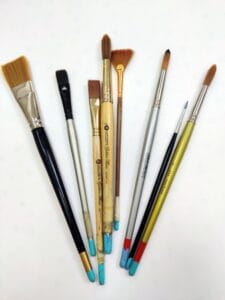A £100 sable brush won’t turn you into Monet overnight. Here’s how to pick brushes that suit your style, without overspending.
Brushes by Medium
- Oils: Stiff bristles (hog/horsehair) for texture.
- Acrylics: Synthetics (nylon/Taklon) stand up to heavy use.
- Watercolour: Soft sable/synthetic blends for smooth washes.
My Hack: I colour-code handles with tape (blue for watercolours, green for acrylics) so that I don’t mix up my brushes and use them across mediums. If I do decide I need to use a watercolour brush for an oil or acrylic piece, having a colour code means I know where to return it to once washed.

When to Splurge vs. Save
- Splurge: A single high-quality round brush for detail work (e.g., Winsor & Newton Series 7).
- Save: Bulk packs of flats/filberts for bold strokes and underpainting.
Care Tips:
- Clean brushes immediately after use (especially with acrylics). If you don’t, trying to get them back into working order is a lost cause.
- Reshape bristles before drying to prevent curling. I leave my brushes hanging over the edge of my sink to dry and then I place them bristles up in old yoghurt pots.
Final Truth: Great brushes help, but technique is king. A skilled artist can work magic with a cheap £5 brush, so my advice is to invest in practice first!
NB I do not get paid to endorse any people or brands mentioned in my blogs.
If you enjoyed this post, please like, share and follow me. Sharing, liking and following raises the algorithms in my favour.
Thank you for your support.
